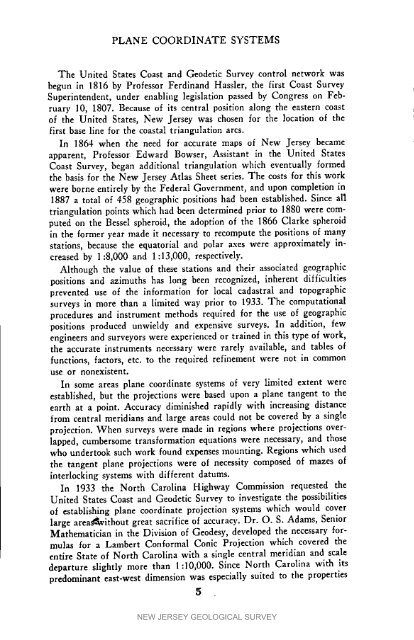NJDEP - NJGS - Bulletin 66, Mapping Digest for New Jersey, 1965
NJDEP - NJGS - Bulletin 66, Mapping Digest for New Jersey, 1965
NJDEP - NJGS - Bulletin 66, Mapping Digest for New Jersey, 1965
You also want an ePaper? Increase the reach of your titles
YUMPU automatically turns print PDFs into web optimized ePapers that Google loves.
PLANE COORDINATE SYSTEMSThe United States Coast and Geodetic Survey control network wasbegun in 1816 by Professor Ferdinand Hassler, the first Coast SurveySuperintendent, under enabling legislation passed by Congress on February10, 1807. Because of its central position along the eastern coastof the United States, <strong>New</strong> <strong>Jersey</strong> was chosen <strong>for</strong> the location of thefirst base llne <strong>for</strong> the coastal triangulation arcs.In 1864 when the need <strong>for</strong> accurate maps of <strong>New</strong> <strong>Jersey</strong> becameapparent, Professor Edward Bowser, Assistant in the United StatesCoast Survey, began additional triangulation which eventually <strong>for</strong>medthe basis <strong>for</strong> the <strong>New</strong> <strong>Jersey</strong> Atlas Sheet series. The costs <strong>for</strong> this workwere borne entirely by the Federal Government, and upon completion in1887 a total of 458 geographic positions had been established. Since alltriangulation points which had been determined prior to 1880 were computedon the Bessel spheroid, the adoption of the 18<strong>66</strong> Clarke spheroidin the <strong>for</strong>mer year made it necessary to recompute the positions of manystations, because the equatorial and polar axes were approximately increasedby 1:8,000 and 1:13,000, respectively.Although the value of these stations and their associated geographicpositions and azimuths has long been recognized, inherent difficultiesprevented use of the in<strong>for</strong>mation <strong>for</strong> local cadastral and topographicsurveys in more than a limited way prior to 1933. The computationalprocedures and instrument methods required <strong>for</strong> the use of geographicpositions produced unwieldy and expensive surveys. In addition, fewengineers and surveyors were experienced or trained in this type of work,the accurate instruments necessary were rarely available, and tables offunctions, factors, etc. to the required refinement were not in commonuse or nonexistent.In some areas plane coordinate systems of very limited extent wereestablished, but the projections were based upon a plane tangent to theearth at a point. Accuracy diminished rapidly with increasing distancefrom central meridians and large areas could not be covered by a singleprojection. When surveys were made in regions where projections overlapped,cumbersome trans<strong>for</strong>mation equations were necessary, and thosewho undertook such work found expenses mounting. Regions which usedthe tangent plane projections were of necessity composed of mazes ofinterlocking systems with different datums.In 1933 the North Carolina Highway Commission requested theUnited States Coast and Geodetic Survey to investigate the possibilitiesof establishing plane coordinate projection systems which would coverlarge areas_t,eithout great sacrifice of accuracy. Dr. O. S. Adams, SeniorMathematician in the Division of Geodesy, developed the necessary <strong>for</strong>mulas<strong>for</strong> a Lambert Con<strong>for</strong>mal Conic Projection which covered theentire State of North Carolina with a single central meridian and scaledeparture slightly more than 1:10,000. Since North Carolina with itspredominant east-west dimension was especially suited to the properties5NEW JERSEY GEOLOGICAL SURVEY
















